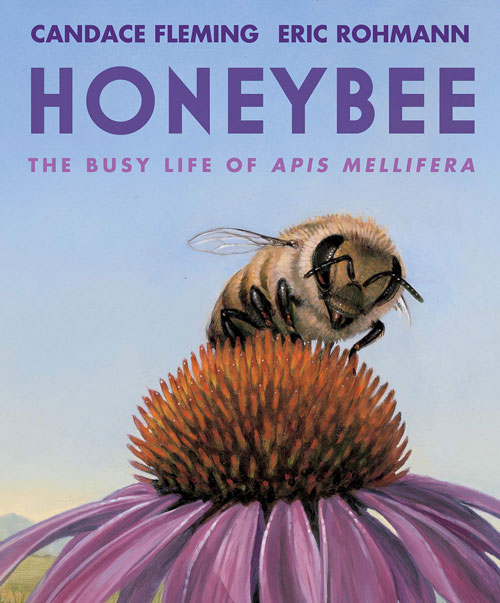2018 School Spending Survey Report
Honeybee
The Busy Life of Apis Mellifera
Holiday House/Neal Porter.
Feb. 2020.
40p.
Tr $18.99. ISBN 9780823442850.
COPY ISBN
 K-Gr 4–Prior to the title page, two full-page close-ups show a honeybee emerging from her wax cell. The free verse poem that runs through the entire book helps readers envision the start of this life cycle. The text and the accompanying illustrations work together masterfully. The vocabulary is precise and razor sharp: each word makes an impact, adding a crucial detail. The language also generates and sustains curiosity. Early on in the narrative, Fleming wonders if the honeybee is ready to fly, but the answer is “not yet.” Other jobs come first—cleaning, nursing, queen tending, comb building, food handling, and guarding. The bee finally takes flight “on the twenty-fifth day of her life.” It is worth the wait. Rohmann’s illustrations make a dramatic transition. The previous oil-on- paper illustrations are amazingly detailed, large, and easy to examine. The warm colors of the hive (brown, black, yellow) show a safe, secure environment. But as Apis Mellifera peers out from the hive, the perspective radically changes, and a four-page gatefold of a sunny meadow with a field of flowers is visible. Readers follow the insect through each of her jobs until her end, where a new honeybee takes her place. It’s an impressive cycle.
K-Gr 4–Prior to the title page, two full-page close-ups show a honeybee emerging from her wax cell. The free verse poem that runs through the entire book helps readers envision the start of this life cycle. The text and the accompanying illustrations work together masterfully. The vocabulary is precise and razor sharp: each word makes an impact, adding a crucial detail. The language also generates and sustains curiosity. Early on in the narrative, Fleming wonders if the honeybee is ready to fly, but the answer is “not yet.” Other jobs come first—cleaning, nursing, queen tending, comb building, food handling, and guarding. The bee finally takes flight “on the twenty-fifth day of her life.” It is worth the wait. Rohmann’s illustrations make a dramatic transition. The previous oil-on- paper illustrations are amazingly detailed, large, and easy to examine. The warm colors of the hive (brown, black, yellow) show a safe, secure environment. But as Apis Mellifera peers out from the hive, the perspective radically changes, and a four-page gatefold of a sunny meadow with a field of flowers is visible. Readers follow the insect through each of her jobs until her end, where a new honeybee takes her place. It’s an impressive cycle.
VERDICT This book is nonfiction at its best—a combination of beautifully crafted language and astonishing close-up illustrations. Fleming displays admiration for honeybees and conveys enormous respect for their work.
RELATED
ALREADY A SUBSCRIBER? LOG IN
We are currently offering this content for free. Sign up now to activate your personal profile, where you can save articles for future viewing





Be the first reader to comment.
Comment Policy:
Comment should not be empty !!!